Magna Britannia: Volume 4, Cumberland. Originally published by T Cadell and W Davies, London, 1816.
This free content was digitised by double rekeying. Public Domain.
Daniel Lysons, Samuel Lysons, 'Antiquities: Ancient church architecture', in Magna Britannia: Volume 4, Cumberland(London, 1816), British History Online https://prod.british-history.ac.uk/magna-britannia/vol4/clxxxix-ccii [accessed 8 February 2025].
Daniel Lysons, Samuel Lysons, 'Antiquities: Ancient church architecture', in Magna Britannia: Volume 4, Cumberland(London, 1816), British History Online, accessed February 8, 2025, https://prod.british-history.ac.uk/magna-britannia/vol4/clxxxix-ccii.
Daniel Lysons, Samuel Lysons. "Antiquities: Ancient church architecture". Magna Britannia: Volume 4, Cumberland. (London, 1816), British History Online. Web. 8 February 2025. https://prod.british-history.ac.uk/magna-britannia/vol4/clxxxix-ccii.
In this section
Ancient Church Architecture.
Saxon. — Remains of Saxon architecture are to be seen in many of the churches of Cumberland, though few of them are entitled to any particular notice, except those in the nave and south transept of Carlisle cathedral, and in the churches of Aspatria and Torpenhow. The style of the first, which is most probably part of the building erected by William Rufus, is plain and massy; a specimen of this is exhibited in the annexed Plate. In Aspatria church, the great arch and the south door-way are richly ornamented with braids and chevron mouldings; and some of the original small round-headed windows are to be seen in the north wall of the nave and of the belfry. The great arch in Torpenhow church is enriched with chevron mouldings; the capitals of the half pillars on each side are remarkably ornamented, one of the sides being formed by an assemblage of grotesque heads, the other by human figures with interlaced arms. The great arches and the door-ways of Bridekirk, Irthington, Isell, and Kirkbampton churches are in the same style, but less ornamented; within the arch of the north door-way of the last, there is a rudely-sculptured bas-relief, representing two animals and what seems to have been designed for an abbot.
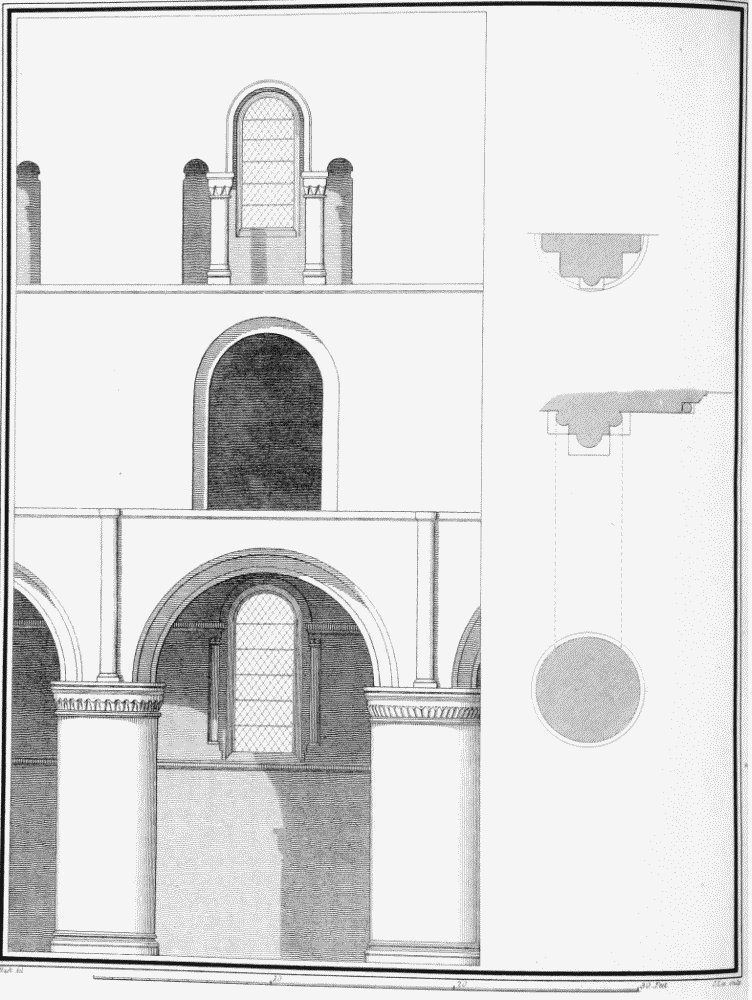
Part of the nave of Carlisle cathedral
Kirklinton is a very complete Saxon church, having undergone no alteration. The nave is a parallelogram of 30 feet by 18 feet 6 inches; the chancel, of 32 feet by 14 feet 6 inches. The great arch is ornamented with chevron mouldings. Warwick Church is in the plain Saxon style: the east end terminates in a semicircle, where are thirteen narrow round-headed niches in some of which are very small windows. (fn. n1)
The great west door of the church of St. Bees is ornamented with grotesque heads and chevron mouldings; and door-ways with circular arches and Saxon ornaments remain in the churches of Bromefield, Burgh on the Sands, Dearham, Edenhall, Grinsdale, and Great-Salkeld.
Early Gothic.—The remains of Holme-Cultram Abbey and of Lanercost Priory churches, exhibit specimens of the earliest Gothic architecture, of the middle and latter part of the twelfth century, having the pointed arch united to the massy pillars of the preceding style. Of Holme-Cultram abbey, which was founded in the year 1150, great part of the nave remains, now used as the parish church; the great west door has four small pillars on each side, and the arch is inriched with numerous plain mouldings. Lanercost Priory was founded in the year 1169; and there is every reason to conclude that the whole of the choir and transepts, now in ruins, and the lower part of the nave, at present used as the parish church, are parts of the original edifice. Specimens of these are shewn in the annexed Plates.
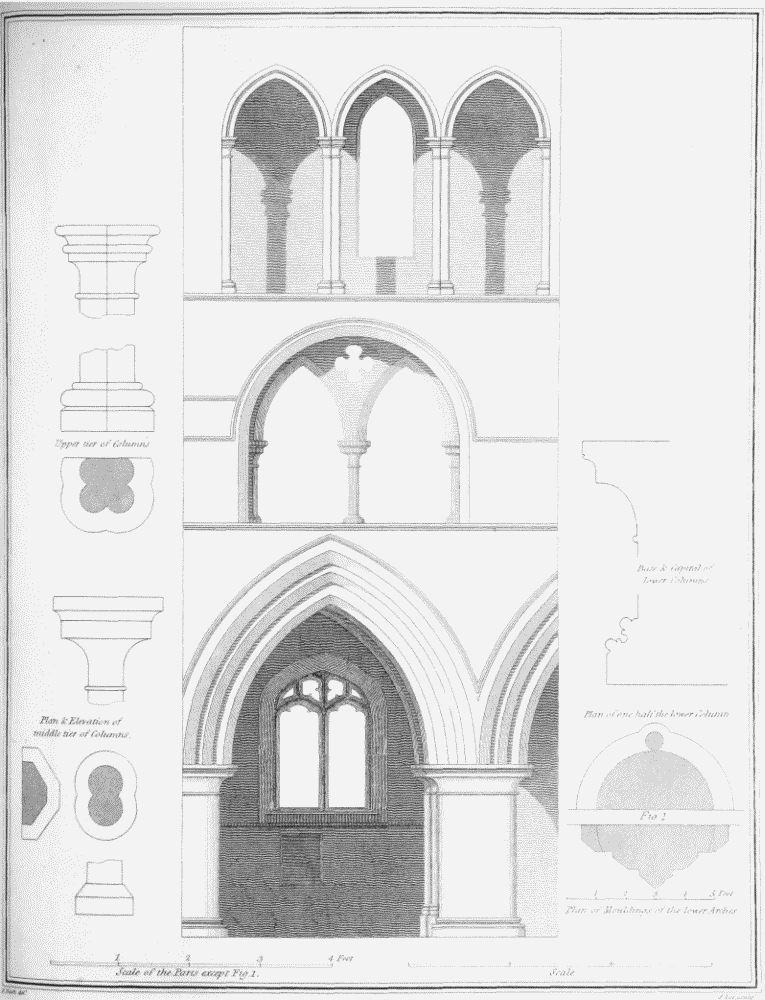
Part of the choir of Lanercost priory church
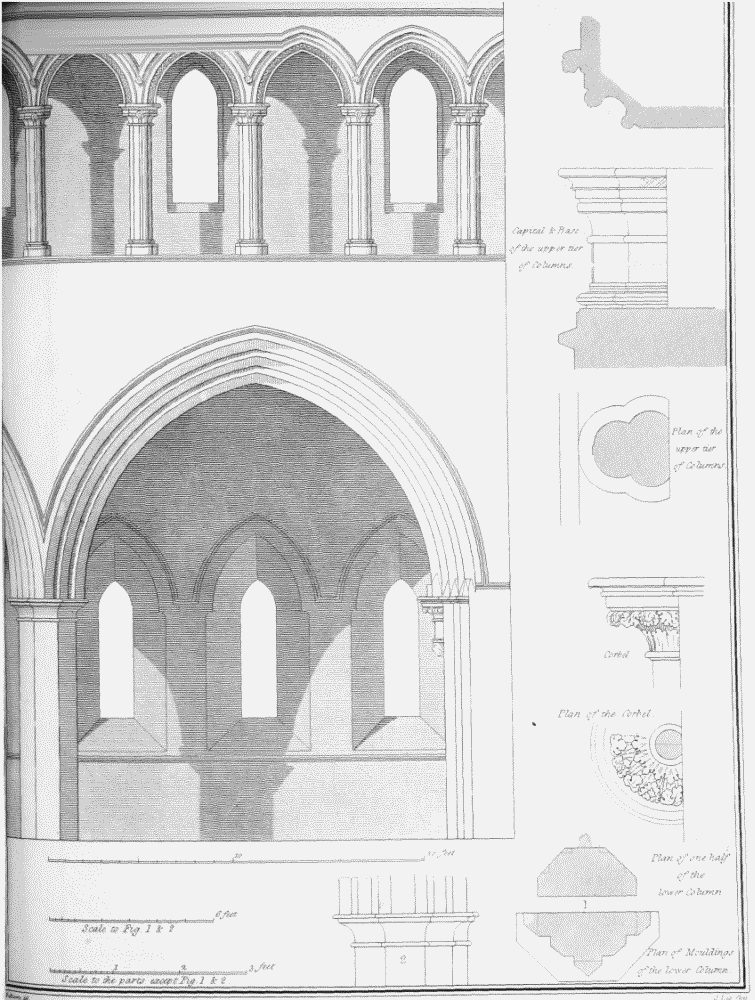
Part of the nave of Lanercost priory church
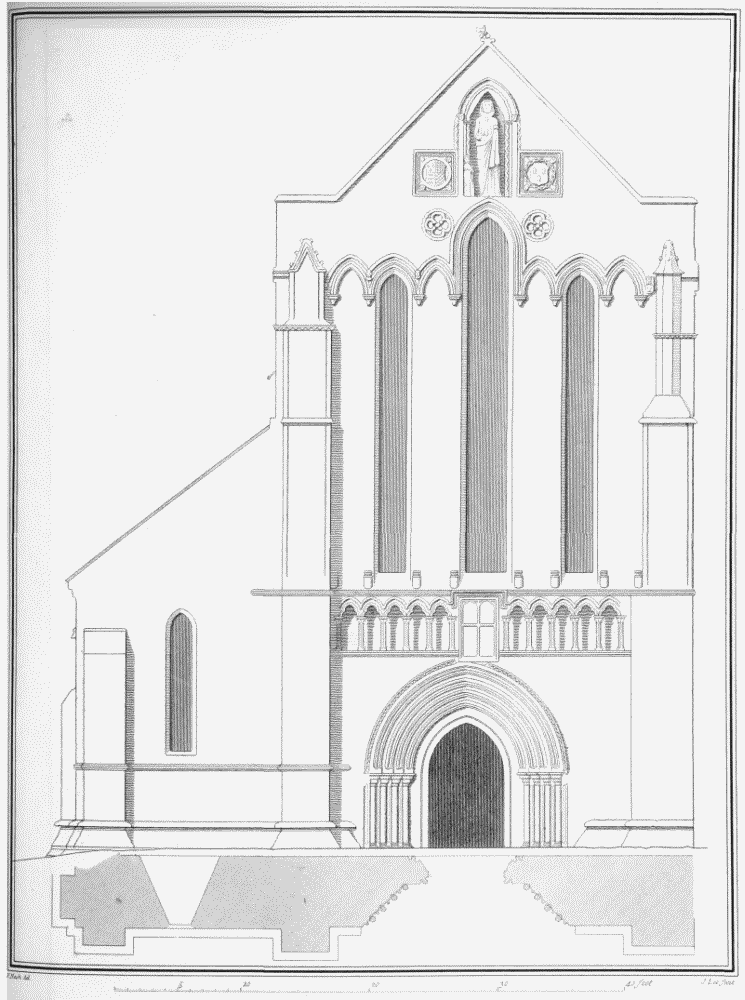
Elevation of the west end of Lanercost priory church
Thirteenth Century.—The west end of Lanercost Priory church, the east end of that of St. Bees, now in ruins, and the aisles of the choir of Carlisle cathedral, are in the style of the early Gothic, with lancet-shaped windows and slender shafts between them: the east end of Egremont church, and what remains of that of Seton Priory, are in this style. The large clustered pillars in the choir of Carlisle cathedral, the capitals of which are much enriched with sculptured foliage, and the pointed arches with a great variety of mouldings, are in the style of the latter part of this century.
Fourteenth Century.—There are few remains of the ecclesiastical architecture of this century in Cumberland, except the upper part of the choir of Carlisle cathedral and the east end, the elevation of which is shewn in the annexed Plate. This part of the church having been destroyed by fire, at the close of the preceding century, is said to have been rebuilt in the reign of King Edward III. The destruction does not appear to have extended to any great part of the building except the roof, for nearly the whole of the choir and north transept still existing are of an earlier age, as already noticed. At the east end of the south aisle of Brigham church is a handsome window in the style of this century.
Sixteenth Century. — The only specimen of the latest Gothic architecture which we observed in this county, occurs at the west end of Holme-Abbey church, where there are two niches, the arches and pinnacles of which are much enriched with crockets, &c. with inscriptions in text hand (fn. n2), from which it appears that the image of the Virgin Mary formerly stood in one of them, and that the work was executed in the year 1507, when Robert Chamber was abbot. There are two shields on the sides of the door-way, one of which is charged with a lion rampant and cross, the other with a bear and crosier, and the initials R. C. (fn. n3)
Border Churches. — There are some remarkable ecclesiastical edifices in the county of Cumberland on the borders of Scotland, which, as they lie out of the ordinary route of travellers, have been little noticed. The towers of two of these, Newton-Arlosh church, near the western coast, and Burgh on the Sands, near the Solway Frith, appear to have been very strong, and capable of affording protection to the inhabitants of the villages, for some time, upon any sudden invasion from the opposite coast across the Frith; the cattle were probably secured in the body of the church.
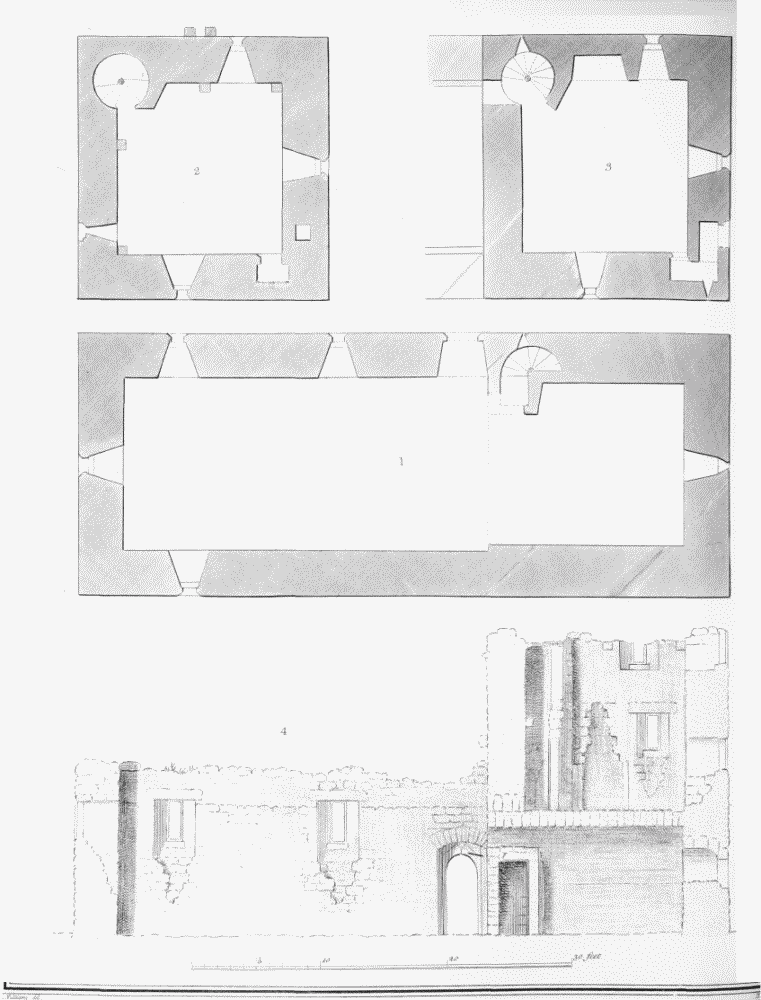
Newton Arlosh church
1. - Plan; 2. - Plan of second storey of tower; 3. - Plan of third storey of tower; 4. - Section from east to west
Newton-Arlosh church was built soon after 1303. (fn. n4) On the ground floor in the tower is a vaulted chamber 13 feet square, with a small aperture, 18 inches high and 9 inches wide, on the west side; over this was a chamber nearly of the same dimensions, with three narrow windows or rather arrow-slits on the north, south, and west sides: it had a fireplace on the south side; and a passage through the wall at the north-west corner, leading to a larger opening. The chamber on the upper story is of the same dimensions, nearly resembling that on the first floor, except that it has a fourth window, on the east side, and no fire-place (fn. n5). There is a stone staircase in the south-east angle of the tower, leading to the upper chambers. So great has been the attention paid to security, in the construction of this edifice, that the principal window at the east end, over the altar, is only eleven inches in width.
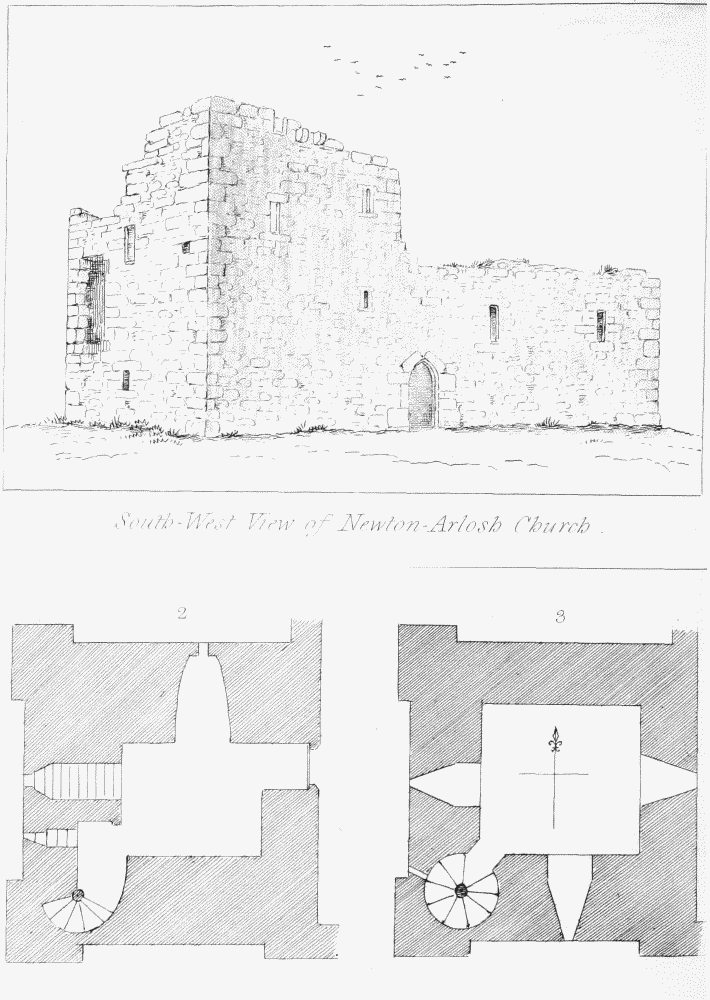
Border churches
1. - South-west view of Newton Arlosh church; 2. - Plan of ground floor of Burgh-on-the-Sands church; 3. - Plan of upper chamber of tower, Burgh-on-the-Sands church
The tower of the church of Burgh on the Sands is still more strongly fortified (fn. n6), the walls on three sides being from six to seven feet thick: the vaulted chamber on the ground-floor is only ten feet by eight, and the entrance to it from the church is secured by a ponderous iron door, six feet eight inches in height, with two large bolts, exactly resembling one remaining at Naworth Castle. On the north side of the chamber is a very narrow opening or arrow-slit, at the end of a recess in the wall six feet three inches deep; and on the west side are two such openings, (one of them only three inches wide) with steps leading up to them. At the southwest angle is a stone staircase, leading to the upper chamber, the dimensions of which are 10 feet 9½ inches by 11 feet 7½ inches: on the east side of the room is an opening into the upper part of the nave of the church, and on the south and west sides are small narrow windows. This tower was probably built in the reign of King Edward I. Many hewn stones appear in different parts of the building with the exterior surface hatched, evidently taken from the wall of Severus, or the station of Alexolodunum, which was at this place, about 200 yards east of the church.
The tower of Great-Salkeld church was also strongly fortified (fn. n7); at the entrance from the nave is a massy grated iron door, lined with oak; the chamber on the ground-floor is vaulted like those of Burgh on the Sands and Newton-Arlosh. In the chamber on the first floor there is a fire-place; over this chamber have been two others, with floors of timber.
Painted Glass. — Very few remains of ancient painted glass are to be seen in any of the Cumberland churches: when we visited this county in the year 1808, we observed in a north window of the chancel of Edenhall church, figures of the Virgin and Child, and of a Saint in the habit of a Bishop, holding a King's head in his left hand, an outline of which is introduced in the margin. This is supposed to have been intended for St. Aidan, Bishop of Lindisfarn, carrying the head of Oswald, King of Northumberland. We learn that this figure has been since taken away from the church. Under the figure of the Virgin were portraits of a lady kneeling, with four others behind her. In a north window of Crossthwaite church we observed the upper part of a figure of St. Anthony, holding a book in his right hand, and a bell in his left.
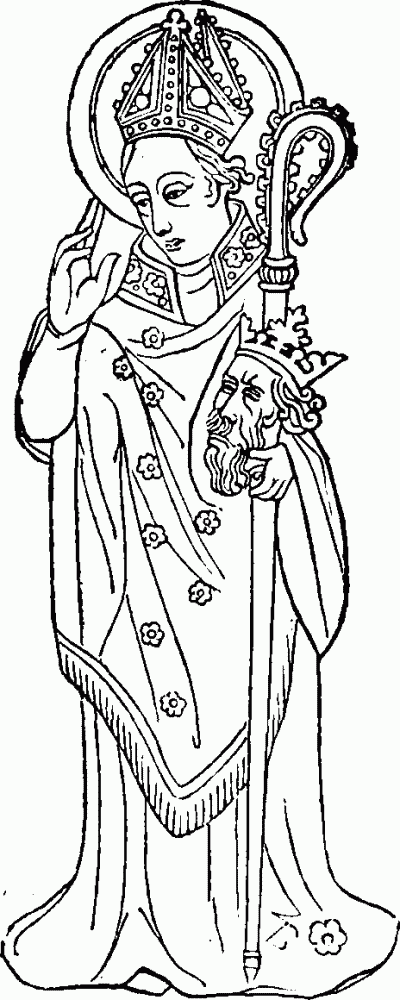
Figure in glass of Edenhall church
The east window of Greystock church appears to have been richly ornamented with historical subjects, relating to St. Andrew, in eight compartments, now much mutilated, accompanied with inscriptions on scrolls. Here is also the portrait of an ecclesiastic, with this inscription in text hand, "Orate pro a[nim]a d[omi]ni Thoma. Beaucha . . . . . . istius Eccl[esia]e;" and many other fragments of portraits, and figures of Saints.
Stone Stalls, &c. — At Brigham, in the south wall of the south aisle, are three stone stalls, and a piscina enriched with crockets; and the same number of stalls in Greystoke and Ousby churches, the former with plain pointed arches and detached pillars, in the style of the early Gothic; the latter with trefoil arches.
Fonts. — The font best entitled to notice in this county, and probably the most curious one in the kingdom, is that in Bridekirk church, the four sides of which are exhibited in the annexed Plates. They are all enriched with sculptures in bas-relief, the style of which would clearly indicate it to be the work of an earlier age than that of the Norman conquest, if it had not the Dano-Saxon inscription on the south side, in Runic characters; which was first satisfactorily explained by Bishop Nicolson, in a letter to Sir William Dugdale, published in the fifteenth volume of the Philosophical Transactions. He reads it thus, "Er Ekard han men egrocten. and to dis men red wer Taner men brogton;" i. e. "Here Ekard was converted, and to this man's example were the Danes brought." The scroll on which this inscription is cut rests on two pillars, one of which is evidently clustered, and of a lighter style than that which prevailed a short time before the Conquest.
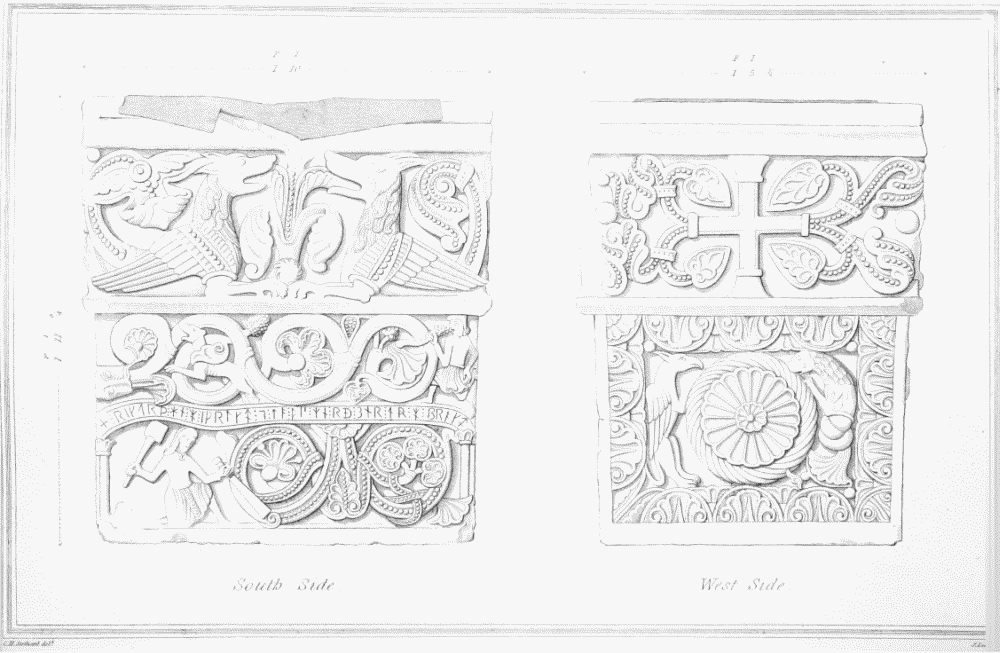
Bridekirk font
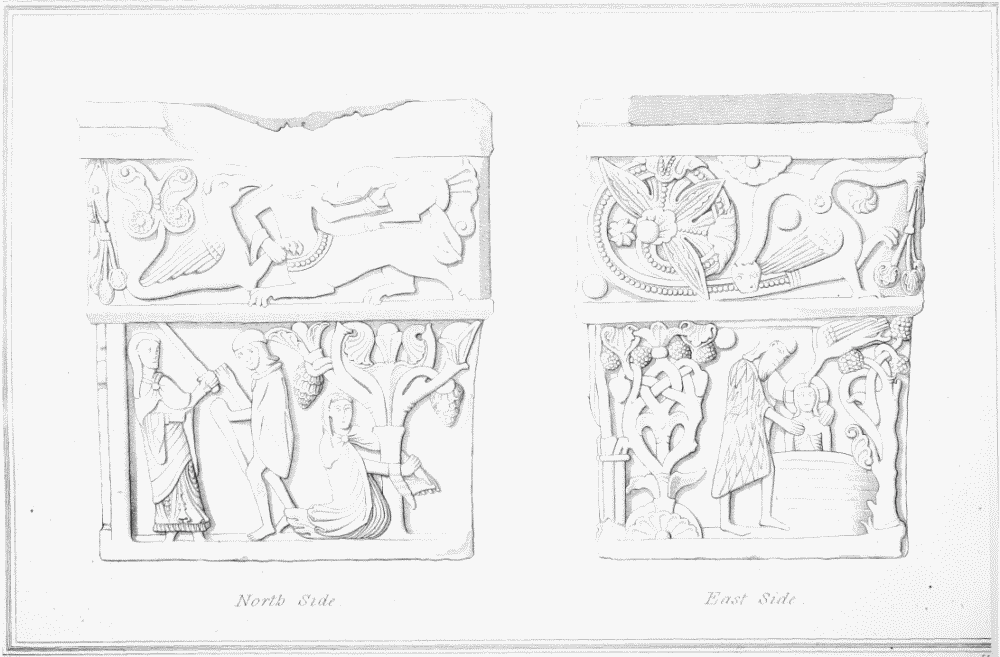
Bridekirk font
On the south side of the font, immediately over the inscription, is a scroll of vine-branches, proceeding from a grotesque head; with the figure of a man at the opposite end, eating one of the bunches of grapes: beneath it is introduced the figure of a sculptor, with his mallet and chisel, executing a scroll. In the upper part of this and the north and east sides, are introduced various grotesque animals and foliage, with a sort of cross florée on the west side. The east side has a representation of the baptism of our Saviour by John the Baptist, with the dove descending. On the west side is a circular ornament, supported by two grotesque animals, within a border of foliage, which frequently occurs on the Saxon fonts.
The sculpture on the lower part of the north side has been supposed to represent the Angel driving Adam and Eve out of Paradise; but though this subject is to be seen in the sculptured decorations of some ancient fonts, it is difficult to imagine that it was intended to be represented here, as the costume of the three figures, by no means accords with that subject, as we see it expressed in ancient works of art.
Camden says that this font was found in the Roman station at Papcastle, but this is doubted by Bishop Lyttelton (fn. n8), as there had never been a church or chapel there; his Lordship supposes the font to have been of higher antiquity, and that the inscription was added about the beginning of the eleventh century, under the Danish government. But this is very improbable, as the scroll which contains the inscription, is evidently part of the original design. If the font was really found at Papcastle, according to the tradition, it must have been in the chapel of the castle belonging to the Saxon lords of Allerdale, which is not very probable: it is much more likely that it should have been a donation to the church, where it remains, by Ekard, who had embraced Christianity, and who no doubt was a person of consequence.
There are several other fonts in the churches of Cumberland which may be referred to the Saxon times; the most remarkable of these, which are all of a square form, are, the old one at Bowness (fn. n9), and those in the churches of Aspatria and Cross-Canonby, and of Dearham, the four sides of which are represented in the annexed Plate.
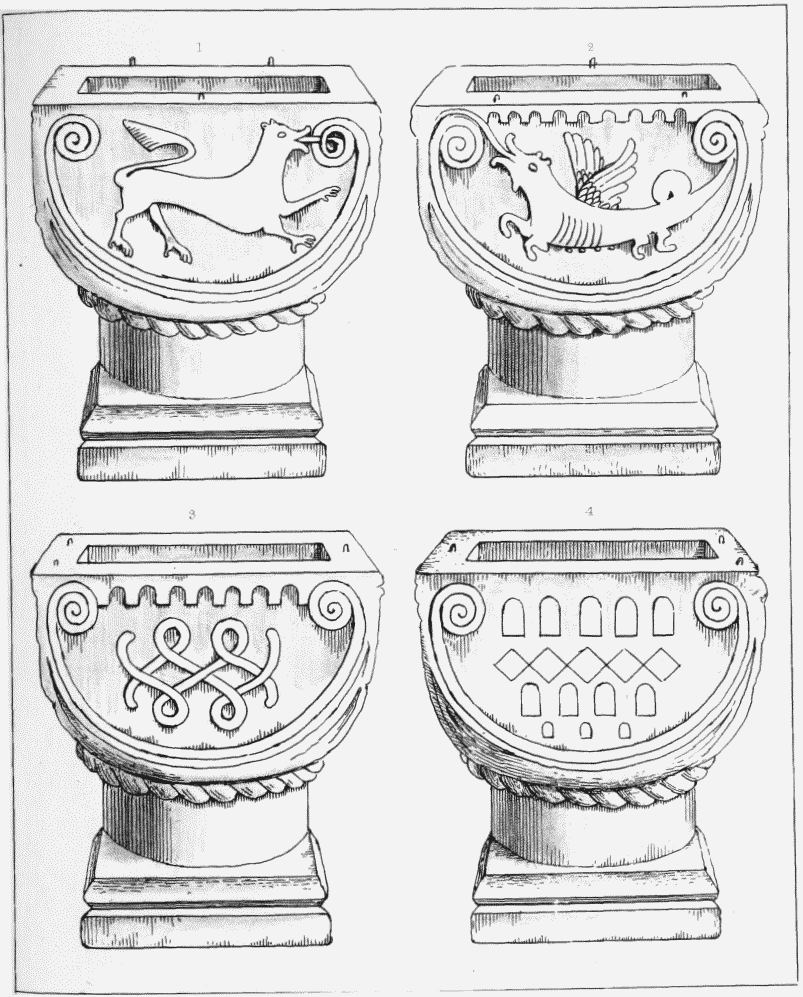
The font in Dearham church
The font in Bootle church is octagonal, with two shields on each side; one of them contains a bugle horn and the initials J. H. in text hand: an inscription in text hand, "In nomine patris & filii," &c. is continued through several others.
Ancient Sepulchral Monuments. — The churches and church-yards in Cumberland abound with ancient grave-stones, some of which, from the form of the letters inscribed on them, may be referred to a very early period. Over one of the windows on the south side of the nave of Dearham church, is a grave-stone, with a cross-florée and sword, having the words "Kestula Radulp.." (Cestula Radulphi, the coffin of Radulphus,) cut on it, in very uncouth characters (fn. n10). In the church-yard of Irthington is a grave-stone with the cross florée and sword, and this inscription, "Hic jacet Radulfus:" this, from the form of the letters, (particularly the H and T, which are Roman,) is probably of as early a date as the reign of King Henry II. (fn. n11) A grave-stone in Aspatria church-yard, with a cross-florée, is thus inscribed in Lombardic capitals, "Hic jacet Bartholomeus de Uchtersat (fn. n12)," i. e. Outerside, one of the hamlets of that parish. Another, in Bassenthwaite church, has a cross-florée and sword, with this inscription in Lombardic characters, "Hic jacet Robertus de Hehmor [i. e. Highmore]: . . . . . nime propicietur Deus (fn. n13)." A grave-stone in Dearham church, without any inscription, has a very rich cross-florée, from the staff of which proceed branches of oak; on one side is a book, on the other a pair of shears (fn. n14). In the tower of Great-Salkeld church, over the fire-place, is a grave-stone with a cross-florée, on one side of which is a sword and girdle, on the other a bugle horn: the inscription in Lombardic characters is too much obliterated to shew for whom this memorial was intended; but enough remains of it to indicate that he was an officer of the forest of Englewood (fn. n15), " . . . . e Ingelvod." A slab in Melmerby church has a cross-florée with a sword on one side, and a shield on the other, charged with a maunch, the arms of Threlkeld, which family possessed the manor as early as the reign of King Edward I.
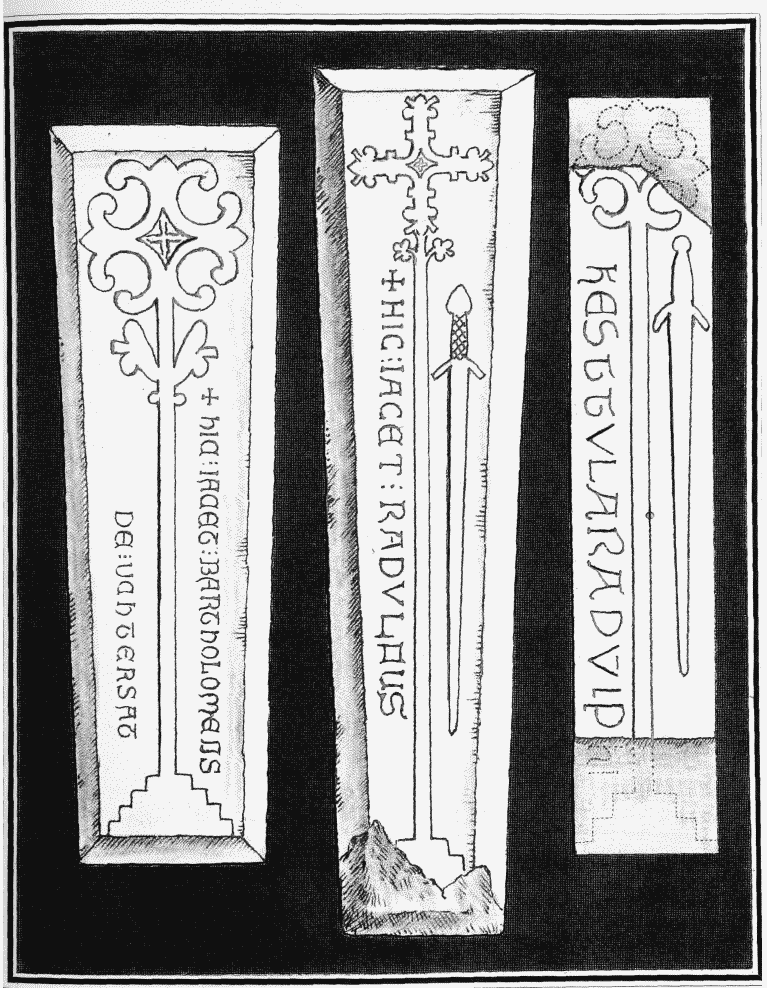
Ancient gravestones in Cumberland
Aspatria, Irthington and Dereham
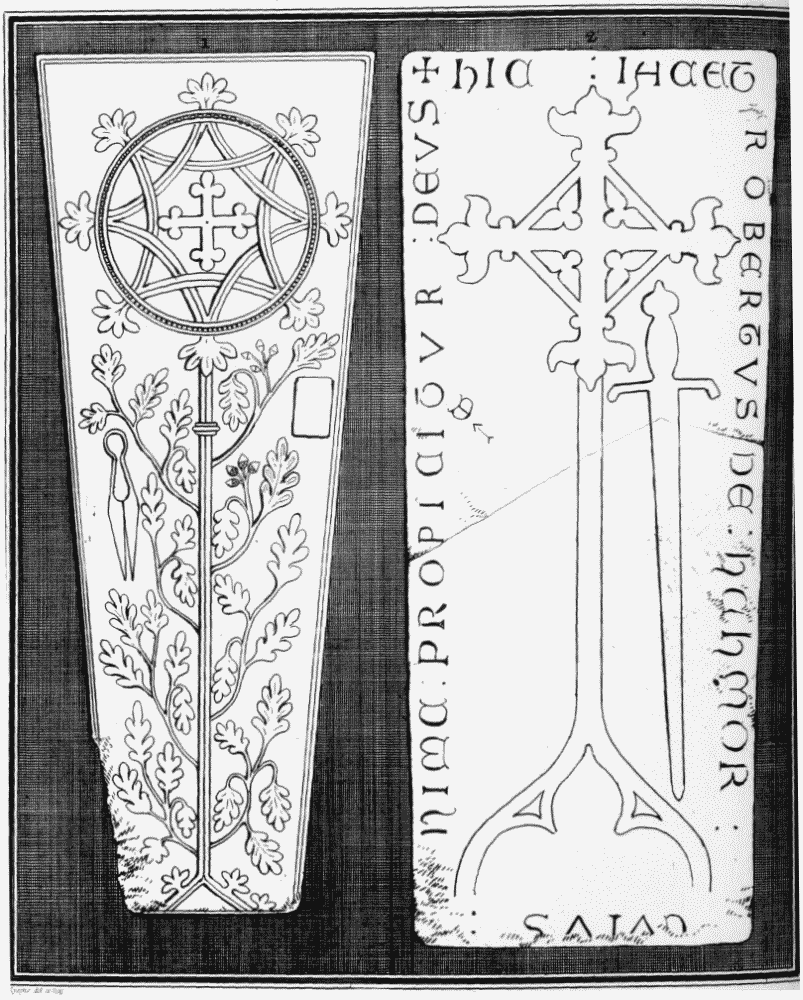
Ancient gravestones in Cumberland
Dearham and Bassenthwaite
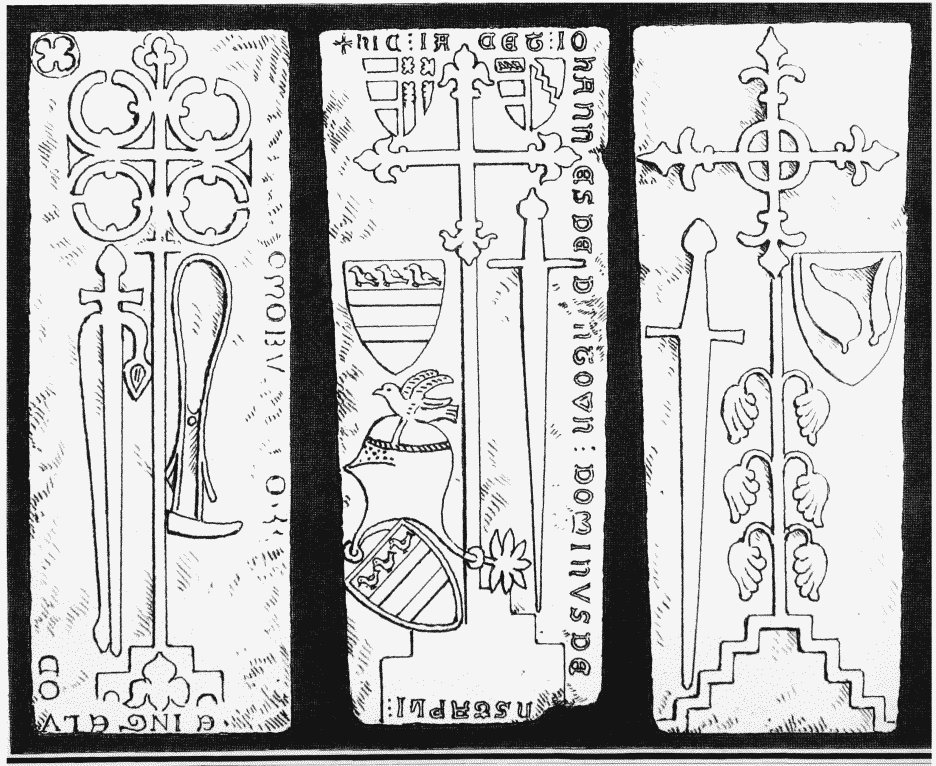
Ancient gravestones in Cumberland
Great Salkeld, Ainstaple and Melmerby
In the church-yards of St. John's and Corney, and in the porch of Dearham church, are grave-stones with the cross and sword, but without any inscription; and under an obtuse arch in the north wall of the north aisle of Bromfield church is a slab, with a cross-florée and a shield charged with a saltier and three cross crosslets in chief; over the arch, in a modern hand, appears this inscription:
"Here lieth entombed I dare undertake
The worthy warriour Adam Crookdake, knight 1514."
Under an obtuse arch, much enriched with crockets, in the south wall of the south aisle of Brigham church, is a slab with a cross-florée. A slab in the ruins of Calder Abbey has this inscription in Lombardic capitals, "Hic jacet dompnus Robertus de Wilughby Abbas de Caldra, cujus animæ propicietur Deus." On another is this fragment of an inscription, . . . . Ricardus Gra . . . . de Kendale . . . . ."
In the chancel of Greystoke church is a grave-stone with a crossflorée, with a shield charged with three cushions, the arms of the first family of De Greystoke, a long sword, and the following inscription, "Johes codam [quondam] Baro de Graystok;" a fac-simile of which is shewn in the following cut.

Grave-stone in Greystoke church
This must have been John Baron of Greystoke who died without issue male, having settled the barony of Greystoke upon his kinsman Ralph Lord of Grimesthorp. In the same place is a brass plate with the epitaph of William Baron of Greystoke, who died in 1359. In Hutton church is a grave-stone with a cross-florée, on one side of which is a bugle-horn, on the other a shield, charged with a crescent on a canton.
In the chancel of Ainstable church is a grave-stone with a cross-florée, and a sword; and four coats of the arms of Denton (fn. n16), two of them with empalements. The lower coat is placed diagonally under the helmet and crest, a fashion which prevailed in the latter end of the fourteenth, and the beginning of the following century. Round the verge of the stone is the following inscription, "Hic jacet Johannes de D . . ntown Dominus de . . . . nstapli."
On the north side of the chancel in Dacre church is the effigies of a crusader, carved in stone, on the floor, a good deal mutilated; which seems to have been of the time of King Henry III.: and one of oak in a recess on the south side of the nave in Ousby church.
In the ruins of the north transept of Calder Abbey church, lie three mutilated effigies of knights, in mail armour and surcoats; two of them having shields, one charged with six lions rampant, and a label of five points, the other fretty. In the south aisle of Millom church, the ancient burialplace of the Hudleston family, is the mutilated effigy of a knight carved in wood, with a lion at his feet, apparently of the fourteenth century.
In the chancel of Greystoke church is a brass plate, with an inscription in French to the memory of "William le Bone Baron de Graystok," who died 10th July 1359; and a large altar-tomb of alabaster, with the effigies of a knight in plate-armour without a helmet: by his side another effigies of a knight under a canopy, in plate-armour, pointed helmet, and mail gorget, having a lion at his feet. On the side of the monument are figures of angels holding shields charged with the arms of Greystoke.
Nicolson and Burn mention (fn. n17) an effigy in wood, of Anthony the last Lord Lucy of Egremont, as being on the south side of the church of St. Bees; we are not sure whether it remains there, not having observed it: we saw in the church-yard two mutilated effigies of knights lying on part of the site of the choir of the Priory church.
In the north aisle of the choir of Carlisle cathedral is a monument with the effigies of a bishop under a canopy: the sides of the slab containing the effigies are ornamented with foliage like that of Bishop Kilkenny in Ely cathedral. This is said to be the monument of William Strickland, Bishop of Carlisle, who died in 1419 (fn. n18), but it is evidently much more ancient, and from the style of it, was probably designed for some bishop who died before the middle of the thirteenth century.
In the same cathedral, under an arch between the choir and the vestry, formerly the chapel of St. Katherine, is the monument of William Barrow, Bishop of Carlisle, who died in 1429; being an altar-tomb with the effigies of the bishop, having a rich Gothic canopy over his head.

Gravestone of William Stapleton and his wife, Edenhall church
In Edenhall church is a grave-stone with brass plates, on which are engraved the effigies of a knight, in plate armour, and his lady, with this inscription over them in text hand (fn. n19), "Hic jacet Will[el]ms Stapilton Armig' quo[n]dam d[omi]nus de Edenhall qui obiit xxvi die Augusti A° d[omin]i M.CCCC° lviii. Et Margareta uxor ejus que erat filia et heres quo[n]dam Nicholai de Vet'ipont' & d[omi]na de Aldeston Mor Quor' a[n]i[m]ab[us] p[ro]piciet' Deus."
Under the arch, between the nave and south transept of Camerton church, is a low altar-tomb, with the effigies in stone of a knight in plate armour without his helmet, and some animal at his feet: his sword is four feet four inches in length.
On the floor of Cumrew church is the effigies in stone of a lady in gown and mantle; and in Crossthwaite church are two effigies in alabaster of a man and his wife; he is in a gown and mantle, with a purse by his side, and the remains of some animal at his feet: she is habited in a gown and mantle. In a building, in the walks at Nunnery, are the mutilated effigies, in stone, of a gentleman and lady in dresses of the fifteenth century; said to be of the Aglionby family, and to have been removed from St. Cuthbert's church in Carlisle.
In the choir of Carlisle cathedral is the grave-stone of Richard Bell, Bishop of Carlisle, who died in the year 1596, having his effigies engraved on brass under a rich Gothic canopy (fn. n20), with a book in his right hand, inscribed "Hec spes mea in sinu meo," and a scroll over his head, inscribed "Credo quod redemptor meus vivit," &c. Under his feet a tablet with four Latin hexameters, beginning
"Hic marmor fossa Bell presulis en tenet ossa."
Round the verge of the stone is an imperfect inscription, beginning "Hic jacet Reverendus Pater Ricardus Bell quondam Episcopus Karleolensis."
In the south aisle of Millom church is a monument of the Hudleston family, being an altar-tomb, with the effigies of a knight and his lady in marble, much mutilated; he is in plate armour, with his helmet under his head, and having a collar of S.S. She is dressed in a long gown and mantle, with a veil: the sides of the tomb are ornamented with Gothic tracery and shields of arms.
In Wetherall church, between the chancel and north aisle, is a large altar-tomb, ornamented on the sides with quatrefoils, having the effigies of a knight and his lady in alabaster: he is in plate armour, without a helmet; the lady in a close-bodied gown and mantle, having angels supporting her pillow. This was the monument of Sir Richard Salkeld, who died 17 Hen. VII. and his lady. Nicolson and Burn give the following inscription as being inscribed on it (fn. n21), no part of which is now to be seen.
"Here lies Sir Richard Salkeld that knight,
Who in this land was mickle of might,
The captain and keeper of Carlisle was he
And also the lord of Corkbye.
And now he lies under this stane,
He and his lady dame Jane.
The eighteenth day of Februere,
This gentle knight was buried here.
I pray you all that this do see,
Pray for their souls for charitie,
For as they are now, so must we all be."
Remains of Monastic Buildings.
Of the priory of St. Bees little remains but the church, already noticed; the choir of which is in ruins, and the nave used as the parish church. The ruins of the church of Calder Abbey, consisting of great part of the tower, and of the pillars and pointed arches of the nave and transepts, is all which exists of this monastery (fn. n22). Besides the church of the priory of Carlisle, which is the present cathedral church, a considerable part of the monastery remains, now converted into the Deanery, adjoining the city-wall; besides a large building called the Fratry, formerly the refectory of the convent, now used as the Chapter-house; and the gate-house. Part of the nave of Holme-Cultram Abbey church, has been converted into the parish church, as before mentioned; nothing more of the monastery at present remains. When Buck's view was published in 1739 (fn. n23), some of the pillars and arches of the choir were standing, which appear to have been in the same style as those of the nave. The whole of the church of Lanercost Priory has been preserved, except the roof; the different parts of it have been already noticed, under the head of "Ancient Church Architecture." The nave appears to have been converted into the parish church since the publication of Buck's View, in 1739. The east end of the church of the nunnery of Seton, and the gate-house of the priory of Wetherall, are all the remains of those monasteries.
Ancient Crosses and Pillars.
A great number of ancient crosses and stone pillars, enriched with various figures and ornaments, remain in the church-yards of this county. The most curious and perfect of these is the obelisk at Bewcastle, which was first noticed by Camden, has been frequently described; and several very inaccurate figures of it have been published. It is of one stone, 14 feet 6 inches high, 20½ inches in width at the bottom, and 14½ inches at the top on the north and south sides; and 22 inches at the bottom, and 16 at the top, on the east and west sides. At the top is a socket 8½ by 7½ inches, in which no doubt a cross has formerly been fixed. At the bottom on the west side is sculptured, in bas-relief, the figure of a man bareheaded, habited in a gown, which reaches to the middle of his legs, holding a bird (most probably a hawk) on his hand, just above its perch. Immediately over this figure are the remains of an inscription in Runic characters, of which an accurate fac-simile was communicated to the Society of Antiquaries by Henry Howard, Esq. of Corby (fn. n24) : this was so much decayed, more than a century ago, that Bishop Nicolson declined attempting to make out any part of it (fn. n25). Over this is another figure sculptured in bas-relief, which, from the nimbus round the head, has been supposed to represent some saint; but as he holds a roll (the sacred volumen) in his left hand, and the right hand is elevated in the act of benediction, we should rather suppose it was intended for our Saviour, who is frequently so represented in ancient works of art. Immediately above this figure are some faint traces of another inscription of two lines; and over this, a third sculpture in bas-relief, which is described by Bishop Nicolson as "the effigies of the B. V. with the Babe in her arms, and both their heads encircled with glories." This description, which several succeeding writers appear to have copied, without inspecting the original, is very erroneous. The female figure is so defaced that nothing more than the general outline can be distinguished; what she holds in her left arm is much better preserved, and is evidently the holy lamb. The east side is filled with an elegant scroll ornamented with foliage, fruit, flowers, and animals, sculptured in bas-relief, as are five compartments, of flowers and Runic knots, placed alternately, on the south side: in the uppermost but one is a sun-dial. On the north side are also five compartments; two of flowers, two of knots, and the fifth filled with chequer-work, which led some of our early antiquaries into the extraordinary supposition that it was erected by one of the family of Vaux, which bore chequy for their arms (fn. n26). Immediately above the lowest compartment on this side, is a pretty perfect inscription in Runic characters, in one line; which Bishop Nicolson reads "Rynburn," and supposes that it signifies "the final extirpation and burial of the magical Runæ in these parts, upon the conversion of the Danes to the Christian faith; or Ryeeburn, which he took to signify in the old Danish language, cæmiterium, or cadaverum sepulchrum. Immediately above the lowest knot on the south side was a Runic inscription of one line, now so nearly obliterated, that except in a very favourable light, hardly a stroke can be distinctly made out (fn. n27). From what remained of this in Bishop Nicolson's time, he conjectured "that it might possibly be, Gag Ubbo erlat, i. e. Latrones Ubbo vicit." (fn. n28)
Part of the inscription on the west side, was communicated by Lord William Howard to Sir Henry Spelman; and by him in a letter to Olaus Wormius, who has published it, with his answer, in his work on the Danish Monuments (fn. n29). Of the inscription he says, "Vere Gothica seu Runica est," but so inaccurately copied, that he did not pretend to give a satisfactory explanation.
In Irton church-yard is an ancient cross, nine feet eight inches in height, the four sides of which (represented in the annexed Plate) are ornamented with the most elegant scrolls, knots, and frets, very much in the style of the decorations of the celebrated manuscript called the Textus Sancti Cuthberti in the British Museum, which was written about the close of the seventh century. The cross in Gosforth church-yard is fourteen feet in height; the lower part is nearly round, and the upper part nearly square. The four sides, which are represented in the annexed Plate, are enriched with various guilloches, and other ornaments, besides several figures of men and animals in bas-relief; it is remarkable that the figure of a man on horseback on the north side is repeated upside down, and another is represented in the same manner, on the west side. The cross in Dearham church-yard, five feet four inches in height, and that at Muncaster, four feet nine inches high, ornamented with guilloches, are figured in the annexed plate, as is also Rockliffe cross, which is very plain.
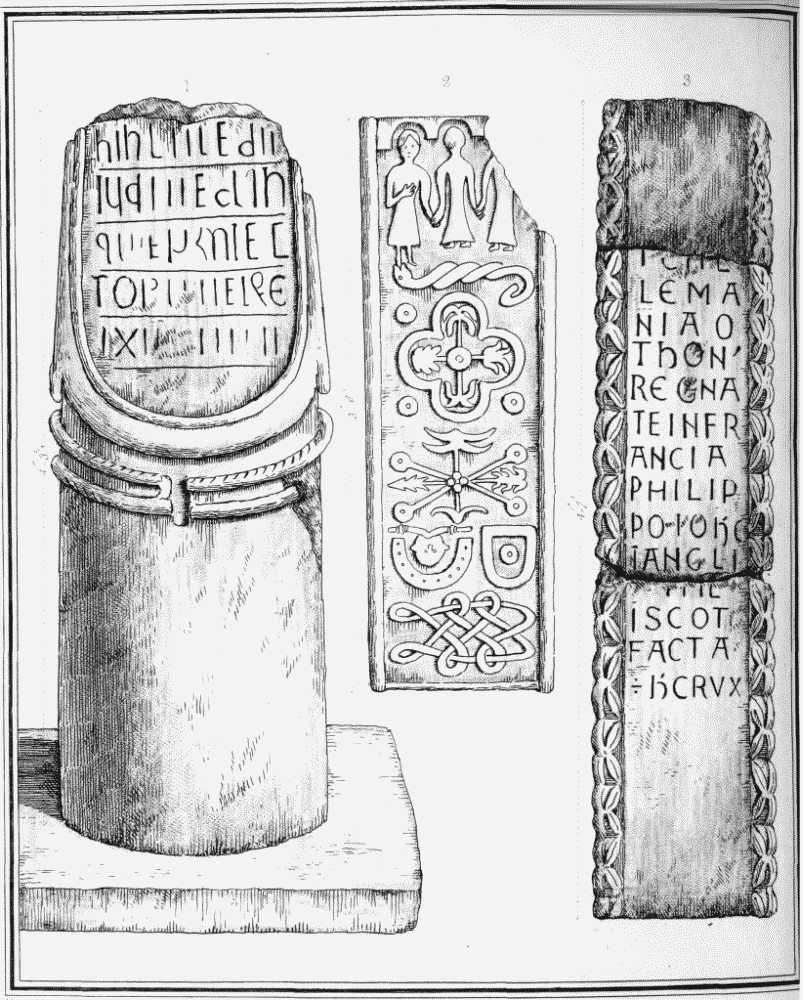
Stones and pillars in Cumberland
In the church-yard of St. Bride's are two stone pillars, each fixed in a large flat stone; the lower part of each is round, the upper part square: one of them, five feet eight inches high, is ornamented with the double guilloche, so common among the Roman architectural ornaments; the other with an elegant double scroll, enriched with foliage on the east side: and on the west, which is represented in the annexed Plate, are the remains of an inscription, apparently Saxon, but in too decayed a state to afford any satisfactory conjecture as to its import: it is probably only a fragment, as the upper part of each of these pillars is broken off. A stone three feet six inches in length, which appears to have been part of an ancient cross, is now used as the transom-stone of a window, in the north aisle of Dearham church: it is covered with rude sculptures in basrelief (fn. n30). In Arthuret church-yard is a plain obelisk of stone, with a cross like that of the Knights-Templars, cut on the upper part of it in bas-relief.
In the church-yard at Penrith are two pillars, one of which is ten feet eight inches high, the other about six inches higher, standing about fifteen feet asunder; the upper part of each is ornamented with various knots and braids, now nearly effaced: each of them is mortised into a flat round stone. Between them are four large stones, which appear to have been originally semicircular, two of which are plain; on the others are several ornaments, and evident remains of some figures rudely sculptured in bas-relief: in a favourable light we could clearly distinguish that of a large serpent and two human figures, one of them apparently a child: and we observe that Sir William Dugdale has expressed them thus, in a drawing of this subject, which he has inserted in his Visitation of Cumberland, preserved in the Heralds' College. This curious monument is commonly called the Giant's Grave, and there is great reason to suppose that it was sepulchral: at no great distance from it is another stone, called The Giant's thumb, which appears to have been a cross, (like those in Cornwall with four holes) from which the upper part has been broken off.
The fragment of a cross, four feet seven inches in length, was dug up a few years since in the church-yard at Lanercost, and is now fixed up on one side of a barn: from the fragment of an inscription which remains on it, we learn that it was made in the reign of King John. It appears, from an entry in the hand-writing of Lord William Howard, in the chartulary of Lanercost Priory (fn. n31), that this cross was dug up in his time in the green before the church; and that the inscription, then entire, was as follows, "Anno ab incaratione MCCXIIII et VII anno interdict. optimente sedem Apo[stoli]cam Innocent III. Imperante in Alemania Othon. Regnante in Franc. Philippo. Joh[ann]e in Anglia. Will[el]mo in Scotia facta h. crux."
In Aspatria church-yard is a stone pillar ornamented with scrolls and braids, much defaced; and in Croglin church-yard a stone cross raised on steps, on one side of which is a braid, on the other a cross-florée.
